jewelry metals guide
At Helzberg Diamonds, metal choice in our jewelry is based on the type of product and how it will be used. For example, we set our engagement rings in gold or platinum so your ring will last for years and years. Diamond fashion jewelry, on the other hand, is most commonly set in gold, while silver is used to give you a large look at a great price. Of course, there are many types of jewelry metals out there for both women's and men's jewelry alike. Our quick guide to understanding metal types is here to help sort them all out. Let's dive in!

types of jewelry metals
Some of the most common metal types used to make jewelry are gold, silver and platinum. Others include titanium, tungsten, tantalum, palladium, cobalt, stainless steel and so many others. Each one has its benefits and differences surrounding durability, comfort, luster, beauty and cost.
types of gold metals
Gold purity is measured in karats. When a metal is 100% pure, like 24K gold, it is too soft and malleable to create long-lasting jewelry. Consequently, it must be alloyed with other metals to give it strength. Here's a quick breakdown of the different gold karats you'll encounter and what they mean:
18k gold
18 parts gold, 6 parts other metals by weight (75% pure)
14k gold
14 parts gold, 10 parts other metals by weight (58.3% pure)
10k gold
10 parts gold, 14 parts other metals by weight (41.7% pure)
Gold is alloyed with specific metal types to give it a white, rose or yellow hue. Depending on your style or priorities, each of these colors offers distinctive characteristics and benefits.

white gold
White gold has a silver appearance and is composed of gold that is typically alloyed with white metals such as palladium, platinum, silver and nickel. It is also commonly plated with rhodium to add to its shine and hardness. This beautiful precious metal is a durable, affordable alternative to platinum. To maintain its lustrous silvery color, white gold rings must have their rhodium coatings re-plated periodically.
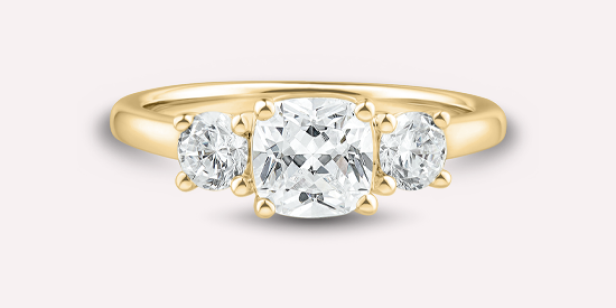
yellow gold
With its warm color and classic appeal, yellow gold is a popular fine metal that never goes out of style. It is typically alloyed with small amounts of silver and copper to make it more resilient and preserve its timeless shine. A staple of many jewelry collections, yellow gold can be used to craft intricate designs for a unique look. To keep your yellow gold pieces looking beautiful, have them polished to maintain their luster.
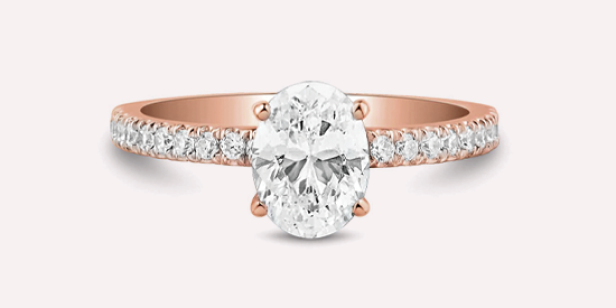
rose gold
Blushing, beautiful rose gold lends a
hint of romance to any ensemble. It is alloyed with copper and silver, giving it a distinct pinkish hue,
like a rose (hence the name). The copper is what gives it a memorable pink coloring. Strong enough for
daily wear, rose gold has unmistakable vintage appeal, and its lovely color flatters most skin tones.
While it looks gorgeous with diamonds, it is especially complementary of morganite
platinum metal
Five times rarer than yellow gold, platinum is a
luxurious metal of exceptional quality. Harder, heavier and far more scratch-resistant than other
metals, platinum is a gorgeous, durable and hypoallergenic option known for its coveted white luster.
Unlike white gold, naturally white platinum does not need to be re-plated or re-polished to avoid
sterling silver
Like 24K gold, pure silver is too soft for making jewelry and will lose its shape over time. Sterling silver, however, is alloyed with metals like copper to create a harder metal. Sterling silver's affordability and appearance make it great for gift-giving.
vermeil
Featuring a thick, 2.5-micron layer of
gold over sterling silver, vermeil (pronounced ver-may) is the highest quality gold plating technique in
the industry. Durable enough for everyday wear, vermeil offers the look and feel of solid gold without
the solid gold price tag. Vermeil is not flash plating, standard gold plating or gold-filled jewelry,
all of which use a thin layer of gold over cheaper base metals like
types of alternative metals
These days, alternative metals are becoming more and more popular for men's bands because of their distinct appearances, durability and affordability. From tantalum and titanium to cobalt, zirconium, meteorite and stainless steel, the following metals offer unique options for a variety of personal styles and needs.
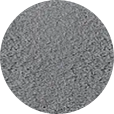
tantalum
First discovered in 1802, tantalum is rare, beautiful, shiny and dense. Extremely resistant to heat and wear, it has become a popular choice for men's wedding bands, thanks to its unique appearance and durable design. Somewhat darker than platinum, tantalum has a rich, masculine color. Tantalum can be polished for a brighter, glossy luster or treated to create a flat, matte finish, which brings out the metal's sleek, stylish texture.
Shop tantalum jewelry
titanium
Titanium has superior structural integrity and is three times stronger than steel. Titanium is also very lightweight (1/3 the weight of gold). Although a very hard and durable metal, titanium can still be scratched by abrasive materials like rocks or hardened steel tools.
An exceptionally rare form of titanium, black titanium has become a popular variation of this popular rare metal. While most black titanium in the market is plated, Helzberg only offers Benchmark black titanium, a true black metal titanium that gets its beautiful look from a proprietary alloying and heating process.
Shop titanium jewelry
stainless steel
Stainless steel is a metal composed of iron alloy and a minimum of 10.5% of chromium. The chromium makes the metal resistant to staining, corroding and oxidation. Stainless steel comes in many grades, meaning it has a variety of uses — including jewelry! This hard, durable and affordable metal is most commonly available in an attractive light gray, making it an appealing metal for men's jewelry.
Shop stainless steel jewelry
cobalt
Often called cobalt chrome, this metal is an excellent choice for men's wedding bands. With its beautiful luster and high durability, cobalt looks similar to white gold and is a long-lasting choice that will maintain its beauty for years to come.
Shop cobalt jewelry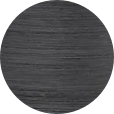
zirconium
Often confused with titanium, zirconium is a refractive metal commonly used in industrial applications and, more recently, in jewelry. In its natural state, the metal is a silvery gray, but it attains a black appearance after a heating process. A durable, lustrous metal, black zirconium is a bold and handsome metal option.
Shop zirconium jewelry
elysium
To create an elysium ring, thousands of diamonds are fused together with incredible heat under one million pounds of pressure. This creates a 100% diamond piece that's extremely lightweight, hypoallergenic and comfortable. Known for its signature black color, elysium jewelry requires no special care and will never dull, fade, scratch or change color. Elysium rings are the hardest and most scratch-resistant rings on the planet and cannot be resized by a jeweler.
Shop elysium jewelry
damascus steel
Named for the capital city of Syria, Damascus steel refers to the forged wootz crucible steel used in the creation of blades and swords from ancient times. Made using iron alloys, modern Damascus steel jewelry is crafted by placing contrasting metals of various shades (often gray and silver) in layers. These layers are then bonded using high heat and shaped by a complicated and artistic process resulting in beautiful patterns.
Shop damascus steel jewelry
meteorite
A meteorite is a chunk of debris from a meteoroid originating from outer space. Meteorite jewelry is usually made from iron meteorites. While there are all sorts of iron meteorites, some are more common than others, including Gibeon meteorite.
A very compelling material for one-of-a-kind men's wedding bands, meteorite is an incredibly rare material billions of years in the making. Because it is exceptionally rare, meteorite jewelry is expensive. It also requires extra care due to its high iron content which leaves it susceptible to rust.
Shop meteorite jewelryfrequently asked questions
Silver is a soft, lustrous, white transition metal valued for its electrical conductivity and decorative beauty. Sterling silver only contains 92.5% silver. The rest is usually made up of copper or some other metal.
Platinum is a lustrous, malleable, silvery-white, ductile metal. It is considered one of the transition metals, a group that includes silver, gold, titanium and copper.
Sterling silver is less durable than white gold, which usually comes with a higher price tag.
Stainless steel resists wear, dings, dents and scratches better than platinum. That said, while modern stainless steel jewelry can be very attractive, platinum jewelry still maintains a superior visual appeal and a higher monetary value.
When it comes to durability, titanium is much harder than platinum. It doesn't scratch, damage or easily lose its shape.
schedule an appointment
Schedule an appointment online or in person to discuss more about moissanite stones and see Helzberg's selection of moissanite rings and jewelry today!
Schedule nowmore advice
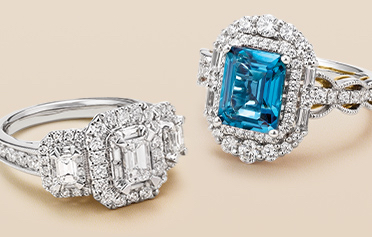
engagement buying guide
Finding the perfect engagement ring can
be overwhelming, but it doesn't
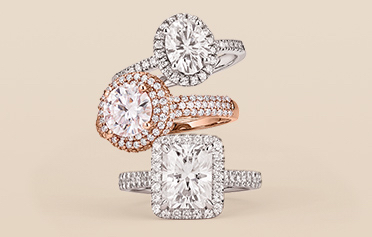
all about moissanite
A stone with major sparkle all its own,
moissanite is a popular
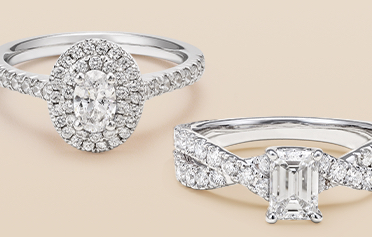
natural vs. lab grown diamonds
Learn the difference between diamonds
mined from the earth and diamonds grown







